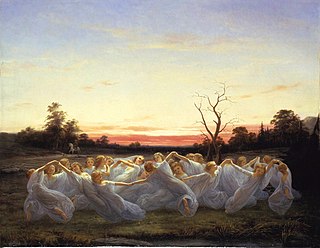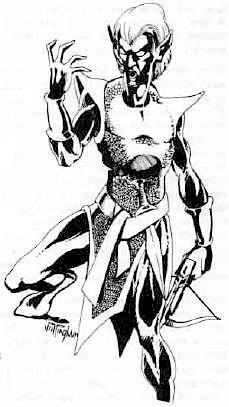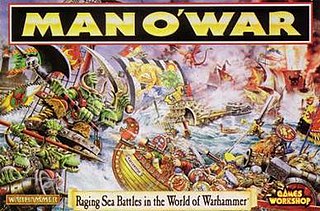
An elf is a type of humanoid supernatural being in Germanic folklore. Elves appear especially in North Germanic mythology, being mentioned in the Icelandic Poetic Edda and Snorri Sturluson's Prose Edda.

The drow or dark elves are a dark-skinned and white-haired subrace of elves connected to the subterranean Underdark in the Dungeons & Dragons fantasy roleplaying game. The drow have traditionally been portrayed as generally evil and connected to the evil goddess Lolth. However, later editions of Dungeons & Dragons have moved away from this portrayal and preassigned alignment. More recent publications have explored drow societies unconnected to Lolth.

Warhammer Fantasy is a fictional fantasy universe created by Games Workshop and used in many of its games, including the table top wargame Warhammer Fantasy Battle, the Warhammer Fantasy Roleplay (WFRP) pen-and-paper role-playing game, and a number of video games: the MMORPG Warhammer Online: Age of Reckoning, the strategy games Total War: Warhammer, Total War: Warhammer II and Total War: Warhammer III and the two first-person shooter games in the Warhammer Vermintide series, Warhammer: End Times - Vermintide and Warhammer: Vermintide 2, among many others.

Drizzt Do'Urden is a fictional character appearing in the Forgotten Realms campaign setting for the Dungeons & Dragons fantasy role-playing game. Drizzt was created by author R. A. Salvatore as a supporting character in the Icewind Dale Trilogy. Salvatore created him on a whim when his publisher needed him to replace one of the characters in an early version of the first book, The Crystal Shard. Drizzt has since become a popular heroic character of the Forgotten Realms setting, and has been featured as the main character of a long series of books, starting chronologically with The Dark Elf Trilogy. As an atypical drow, Drizzt has forsaken both the evil ways of his people and their home in the Underdark, in the drow city of Menzoberranzan.

A campaign setting is usually a fictional world which serves as a setting for a role-playing game or wargame campaign. A campaign is a series of individual adventures, and a campaign setting is the world in which such adventures and campaigns take place. Usually a campaign setting is designed for a specific game or a specific genre of game. There are numerous campaign settings available both in print and online. In addition to published campaign settings available for purchase, many game masters create their own settings, often referred to as "homebrew" settings or worlds.
A half-elf is a mythological or fictional being, the offspring of an immortal elf and a mortal man. They are often depicted as very beautiful and endowed with magical powers; they may be presented as torn between the two worlds that they inhabit. Half-elves became known in modern times mainly through J. R. R. Tolkien's Middle-earth writings but have origins in Norse mythology. A half-elf appeared in Lord Dunsany's 1924 book The King of Elfland's Daughter.
In Norse cosmology, svartálfar, also called myrkálfar, are beings who dwell in Svartálfheim. Both the svartálfar and Svartálfaheimr are primarily attested in the Prose Edda, written in the 13th century by Snorri Sturluson. Scholars have noted that the svartálfar appear to be synonymous with the dwarfs and potentially also the dökkálfar. As dwarfs, the home of the svartálfar could possibly be another description for Niðavellir.
An elf is a mythological creature, originally from Germanic mythology.
Splatbooks are sourcebooks devoted to a particular facet, character class, or fictional faction in a role-playing game, providing additional background details and rules options. For example, a "swords and sorcery" fantasy game might offer splatbooks for each of the races in the setting: humans, dwarves, elves, and others.
An ogre is a large, hideous monster of mythology, folklore and fiction.

Warhammer is a tabletop miniature wargame with a medieval fantasy theme. The game was created by Bryan Ansell, Richard Halliwell, and Rick Priestley, and first published by the Games Workshop company in 1983.
Warhammer Quest is a fantasy dungeon, role-playing adventure board game released by Games Workshop in 1995 as the successor to HeroQuest and Advanced HeroQuest, set in its fictional Warhammer Fantasy world. The game focuses upon a group of warriors who join to earn their fame and fortune in the darkest depths of the Old World.

Man O' War is a now out-of-print table top war game by Games Workshop. The game was set in the same realm of Warhammer Fantasy as used for the Warhammer Fantasy Battle and included most of the factions from that setting. Other races of the Warhammer world were not included, either because they were lacking seafaring abilities, missing from the main factions at that time, or both.

In many works of modern fantasy, elves are depicted as a race or species of pointy-eared humanoid beings. These depictions arise from the álfar of Norse mythology influencing elves in fantasy as being semi-divine and of human stature, whose key traits are being friendly with nature and animals. However, this differs from Norse and the traditional elves found in Middle Ages folklore and Victorian era literature.

The elf is a humanoid race in the Dungeons & Dragons fantasy role-playing game, one of the primary races available for player characters, and play a central role in the narratives of many setting worlds of the game. Elves are described as renowned for their grace and mastery of magic and weapons such as the bow and sword. Becoming physically mature by the age of 25 and emotionally mature at around 125, they are also famously long-lived, capable of living more than half a millennium and remaining physically youthful. Possessed of innate beauty and easy gracefulness, they are viewed as both wondrous and haughty by other races in-universe; however, their natural detachment is seen by some as introversion or xenophobia. They were usually portrayed as antagonistic towards dwarves.
Wood elf is a generic term for an elf that lives in wooded areas such as forests.
In J. R. R. Tolkien's writings, Elves are the first fictional race to appear in Middle-earth. Unlike Men and Dwarves, Elves are immortal, though they can be killed in battle. If so, their souls go to the Halls of Mandos in Aman. After a long life in Middle-earth, Elves yearn for the Earthly Paradise of Valinor, and can sail there from the Grey Havens. They feature in The Hobbit and The Lord of the Rings. Their history is described in detail in The Silmarillion.

In Norse mythology, Dökkálfar and Ljósálfar are two contrasting types of elves; the dark elves dwell within the earth and have a dark complexion, while the light elves live in Álfheimr, and are "fairer than the sun to look at". The Ljósálfar and the Dökkálfar are attested in the Prose Edda, written in the 13th century by Snorri Sturluson, and in the late Old Norse poem Hrafnagaldr Óðins. Scholars have produced theories about the origin and implications of the dualistic concept.








